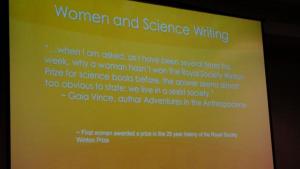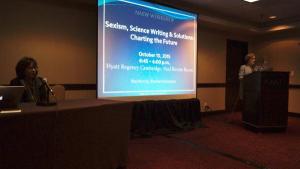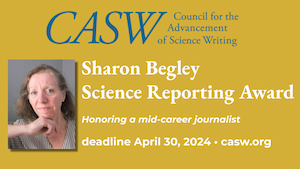When Cristine Russell opened the panel on “Sexism, science-writing and solutions: Charting the future” she pointed out that during the several years the association has been working on the issue, current events have emphasized how central it is both in science writing and in science itself.
Her illustrations included a 2013 scandal over sexual harrassment in the Scientific American blog network, comments this summer by British Nobel laureate Tim Hunt about his “trouble with girls” and new disclosures about sexual harassment of students by a famed California astronomer. In fact, the Hunt saga flared up again shortly after she spoke with the resignation of Sir Colin Blakemore, one of Britain’s leading scientists, “as honorary president of the country’s science writers association over its support for the journalist whose reports led to Hunt’s dismissal”, as the Guardian wrote.
Russell emphasized, though, that while context was important, the purpose of the panel was to focus on the issue in the journalism community.
She was followed by Deborah Blum who presented data showing how the predominance of women in science journalism graduate programs doesn’t later reflect in the profession. The imbalance in favor of men, and at the detriment of women and especially women of color, can be also observed in The Best American Science and Nature Writing anthologies: Blum recalled that when she publicly declared that her goal as an editor would be respect the balance, she was the subject of vitriolic attacks on Twitter, based on the allegation that she was compromising the quality.
The panel addressed many hurdles that stand in the way of women willing to pursue a career in science writing: Apoorva Mandavilli remarked that minority students often need to work and cannot afford to compete for fellowships in prestigious outlets, and Emily Willingham cited sexual harassment and the steps taken in recent years by NASW to produce a Bill of Rights and to address fairness among the members. She also announced that a rich website collecting useful tips and resources for women in the profession is in its final stages and will go live soon.
The role of men was addressed several times: “Men are not the enemy: they are in fact part of the solution” said Christie Aschwanden. “They have a very important role to play by calling out their peers.”
“Dealing with sexism is a professional issue and an ethical issue,” Laura Helmuth concluded.
Many questions and comments from the audience enriched the ensuing discussion: the issue of LGBT minorities was raised, and the general agreement was that science journalists must keep telling the story and everyone must make a special effort to be ready to listen to complaints, resisting the instinctive temptation to dismiss them too rapidly (yes, this can happen to women editors too, it came out).
Getting back to the latest development of the Hunt saga: an informal survey among several fellow NASW members who were in Seoul and heard the speech (or learned immediately after the facts) confirms unanimously that Hunt’s speech was generally perceived as unacceptably sexist.


.png)

